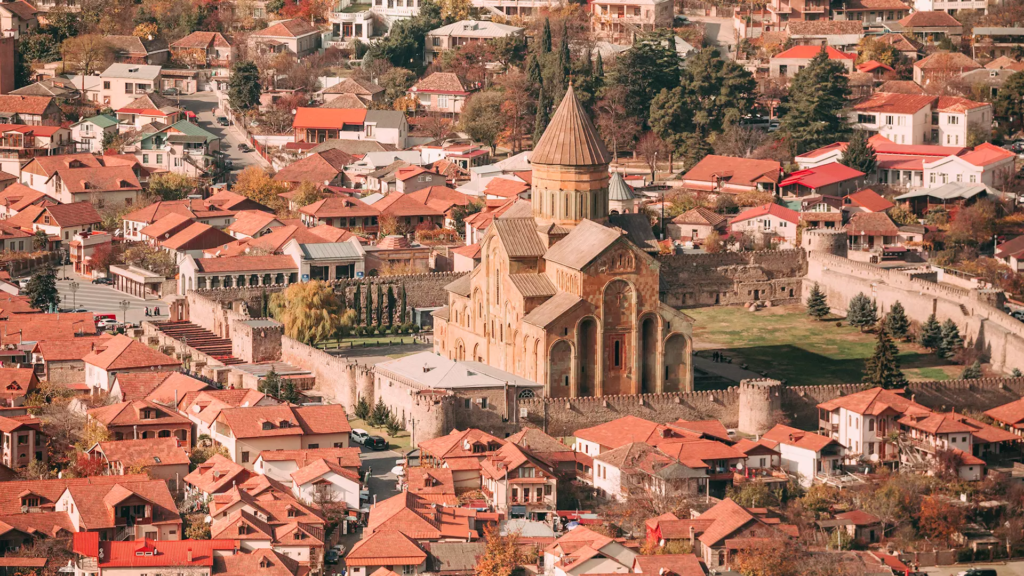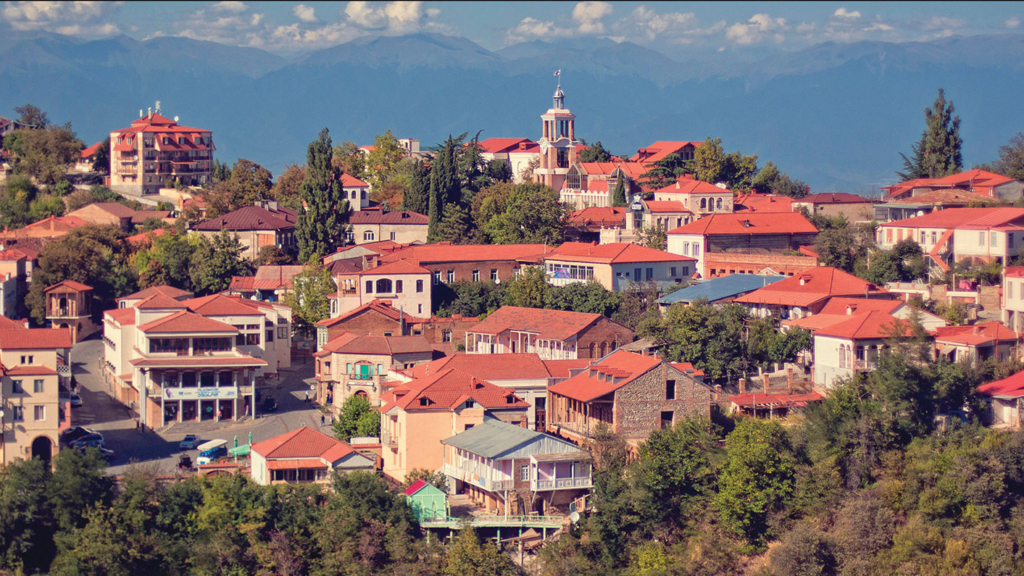Situated at the crossroads of Eastern Europe and Western Asia, Georgia is a country of extraordinary cultural and geographical diversity. Nestled between the Black Sea to the west and the Caucasus Mountains to the north, this country boasts a unique blend of landscapes and a rich historical tapestry. This blog explores Georgia’s stunning geography, vibrant culture, historical significance, and modern attractions, offering a comprehensive guide to understanding and appreciating this remarkable country.
Table of Contents
Geography
Georgia’s diverse geography makes it a fascinating destination. The country spans a range of landscapes, from lush valleys and rolling hills to rugged mountains and serene coastlines. The Greater Caucasus mountain range runs along the northern border, creating a dramatic backdrop of snow-capped peaks and alpine meadows. This range includes Mount Elbrus, which, though technically located in Russia, is visible from parts of Georgia and is the highest peak in Europe.
To the south, the Lesser Caucasus mountains provide a contrasting terrain with its lower peaks and rugged terrain. The fertile plains of the Kolkheti Lowland and the Alazani River Valley in the east offer rich agricultural lands that have supported the country’s viticulture for centuries. The Black Sea coast in the west features a subtropical climate, perfect for enjoying picturesque beaches and lush greenery.
States Of Georgia
The country of Georgia, located at the crossroads of Eastern Europe and Western Asia, is divided into administrative regions. These regions are not states but are key administrative divisions within the country. As of the latest administrative structure, Georgia is divided into the following regions:
| Regions of Georgia |
|---|
| Tbilisi (Capital city) |
| Adjara (Autonomous Republic) |
| Guria |
| Imereti |
| Kakheti |
| Mtskheta-Mtianeti |
| Racha-Lechkhumi and Kvemo Svaneti |
| Samegrelo-Zemo Svaneti |
| Samtskhe-Javakheti |
| Abkhazia (Special status) |
| South Ossetia (Special status) |
Historical Tapestry: From Ancient Times to Modern Era
Georgia’s history is a tale of resilience and cultural richness. The area has been inhabited since prehistoric times, with evidence of ancient civilizations found throughout the region. The ancient kingdom of Colchis, located in modern-day western Georgia, was famous for its wealth and was the backdrop for the Greek myth of Jason and the Argonauts. Colchis was renowned for its golden fleece, which Jason and his crew sought during their legendary quest.
The kingdom of Iberia (modern eastern Georgia) was another significant ancient power. By the 4th century BC, the region had adopted Christianity, making it one of the earliest countries to do so. This adoption of Christianity played a crucial role in shaping Georgia’s cultural and religious identity.
Throughout the Middle Ages, Georgia experienced periods of prosperity and decline. The medieval kingdom of Georgia reached its zenith under King David IV and Queen Tamar in the 12th century, becoming a cultural and political powerhouse. The country’s strategic location made it a target for various invaders, including the Mongols, Persians, and Ottomans. Despite these challenges, Georgia managed to preserve its unique identity and heritage.
In the 20th century, Georgia’s history took a dramatic turn with its incorporation into the Soviet Union. The country gained independence in 1991 following the dissolution of the Soviet Union. Since then, Georgia has been navigating its path as a sovereign nation, balancing modernization with the preservation of its rich cultural heritage.
Cultural Heritage
Georgia’s cultural heritage is a vibrant tapestry woven from various influences. Traditional Georgian music, dance, and art reflect the country’s diverse history and unique identity. The polyphonic singing of Georgia, recognized by UNESCO as an intangible cultural heritage, is renowned for its intricate harmonies and emotional depth.
Georgian cuisine is a highlight of the country’s cultural offerings. Known for its hearty and flavorful dishes, Georgian food features a variety of ingredients and cooking techniques. Some of the most famous dishes include khachapuri (cheese-filled bread), khinkali (dumplings), and pkhali (vegetable patties). Georgian wine is also renowned, with the country being one of the oldest wine-producing regions in the world. The ancient tradition of winemaking, which dates back over 8,000 years, continues to thrive in Georgia’s fertile vineyards.
Traditional Georgian festivals and celebrations, such as the Tbilisi International Film Festival and the Batumi Art Festival, showcase the country’s artistic and cultural vibrancy. Georgian hospitality, known as “supra,” is an integral part of the culture, with elaborate feasts and toasts playing a central role in social gatherings.
Top Eight Most Famous Foods of Georgia








Architectural Marvels
Georgia’s architectural landscape reflects its rich history and dynamic present. The country’s ancient churches and monasteries, such as the Svetitskhoveli Cathedral and the Gelati Monastery, are UNESCO World Heritage Sites and showcase the exquisite craftsmanship of Georgian architects. These structures often feature intricate frescoes and mosaics, highlighting the artistic achievements of their time.
The capital city, Tbilisi, is a blend of historic and modern architecture. The old town of Tbilisi is characterized by its narrow, winding streets and colorful houses with distinctive wooden balconies. The city’s modern skyline, with its glass buildings and contemporary designs, contrasts with the traditional architecture, creating a unique urban landscape.
The town of Mtskheta, once the ancient capital of Georgia, is another architectural gem. The town’s historic sites, including the Jvari Monastery and the Samtavro Monastery, provide insight into the country’s early Christian heritage. These structures, along with their surrounding landscapes, offer a glimpse into Georgia’s architectural evolution over the centuries.
Top Ten Must-Visit Destinations
Georgia, a country of stunning landscapes and rich history, offers a wide array of destinations for travelers. From picturesque mountain ranges and serene coastlines to historic towns and vibrant cities, country’s diverse attractions cater to all kinds of explorers. Here’s a guide to the top ten must-visit places in this beautiful country that showcase the country’s unique charm and cultural heritage.
1. Tbilisi

The capital city, Tbilisi, is a vibrant blend of ancient history and modernity. Wander through the narrow streets of the Old Town to discover colorful houses with ornate wooden balconies. Visit landmarks like the Narikala Fortress, which provides panoramic views of the city, and the holy Metekhi Church. The sulfur baths in the Abanotubani district are a unique experience, offering traditional Georgian relaxation. Don’t miss the modern architecture of the Bridge of Peace and the lively atmosphere of Rustaveli Avenue.
2. Batumi

Located on the Black Sea coast, Batumi is known for its beautiful beaches and lively atmosphere. The city boasts a modern skyline with striking buildings like the Batumi Tower and the Alphabet Tower. Explore the Batumi Botanical Garden, which features diverse plant species and stunning sea views. The seaside promenade is perfect for a leisurely stroll, and the city’s nightlife offers plenty of entertainment options.
3. Mtskheta

A UNESCO World Heritage Site, Mtskheta is one of Georgia’s oldest towns and former capital. Key attractions include the Svetitskhoveli Cathedral, an important pilgrimage site, and the Jvari Monastery, which offers breathtaking views of the confluence of the Aragvi and Mtkvari rivers. Mtskheta’s historical significance and preserved architecture make it a must-visit destination for history enthusiasts.
4. Kazbegi

For breathtaking natural beauty, Kazbegi (now known as Stepantsminda) is a top destination. Nestled in the Greater Caucasus Mountains, it offers stunning vistas of Mount Kazbek. The Gergeti Trinity Church, perched on a hill with panoramic mountain views, is a highlight. The area is ideal for hiking and exploring the surrounding alpine landscapes.
5. Vardzia

Vardzia is a fascinating cave monastery complex built into the cliffs of the Erusheti Mountain. Dating back to the 12th century, this impressive site was carved out of the rock and once housed thousands of monks. The complex includes chapels, living quarters, and a network of tunnels. The dramatic setting and historical significance make Vardzia a unique attraction.
6. Borjomi-Kharagauli National Park

This expansive national park is known for its natural beauty and biodiversity. The park features lush forests, scenic valleys, and picturesque waterfalls. It’s a haven for hikers, offering numerous trails with varying difficulty levels. The famous Borjomi mineral water springs, located near the park, are also worth a visit.
7. Uplistsikhe

Uplistsikhe is an ancient rock-hewn town with a history dating back to the early Iron Age. The site features a network of caves and tunnels carved into the rock, including ancient churches, living quarters, and a theater. Exploring Uplistsikhe provides insight into early Georgian urban planning and architecture.
8. Sighnaghi

Often referred to as the “City of Love,” Sighnaghi is a charming town in the Kakheti wine region. The town is known for its well-preserved medieval architecture, including city walls and watchtowers. Sighnaghi offers picturesque views of the Alazani Valley and is an excellent base for exploring Georgia’s wine country.
9. Ananuri

The Ananuri Fortress complex, located on the Aragvi River, is a stunning example of Georgian medieval architecture. The complex includes two churches and a defensive wall, offering impressive views of the surrounding landscape. The fortress’s picturesque setting by the river makes it a popular spot for photography and historical exploration.
10. Mestia

In the Svaneti region, Mestia is a gateway to the majestic Caucasus Mountains. Known for its traditional Svan towers and ancient churches, Mestia offers a glimpse into the unique culture of the Svan people. The area is also a popular destination for winter sports, including skiing and snowboarding, and offers stunning views of the surrounding peaks.
Natural Beauty
Georgia’s natural beauty is a major draw for outdoor enthusiasts. The country’s diverse landscapes offer numerous opportunities for adventure and exploration. The Caucasus Mountains are a prime destination for hiking, skiing, and mountaineering. The Kazbegi region, with its dramatic peaks and stunning vistas, is particularly popular among trekkers and nature lovers.
In the west, the Black Sea coast provides a different type of natural allure. The seaside town of Batumi is known for its beaches, botanical garden, and modern architecture. The Adjara region, with its lush greenery and waterfalls, offers a serene escape from the hustle and bustle of city life.
The Borjomi-Kharagauli National Park, one of the largest protected areas in Europe, is a haven for wildlife and nature enthusiasts. The park’s diverse flora and fauna, along with its picturesque landscapes, make it a must-visit destination for those seeking a tranquil retreat.
Modern Georgia
In recent years, Georgia has emerged as a dynamic and rapidly developing country. Its capital, Tbilisi, has become a vibrant cultural and economic hub, attracting tourists and entrepreneurs alike. The city’s burgeoning tech scene, innovative startups, and growing infrastructure are contributing to its status as a modern metropolis.
Georgia’s strategic location at the crossroads of Europe and Asia has also positioned it as a key player in regional trade and connectivity. The country’s initiatives to enhance its transportation and logistics infrastructure are helping to bolster its role as a bridge between East and West.
Tourism is a significant part of Georgia’s economy, with visitors drawn to its historical sites, natural beauty, and unique cultural experiences. The government’s efforts to promote tourism and preserve cultural heritage are contributing to the country’s growing appeal as a travel destination.
Conclusion
Georgia is a country that captivates with its rich history, diverse landscapes, and vibrant culture. From the ancient kingdom of Colchis to the modern metropolis of Tbilisi, Georgia’s journey through time is a testament to its resilience and unique identity. Whether exploring its architectural marvels, savoring its delicious cuisine, or experiencing its breathtaking natural beauty, Georgia offers something for every traveler.
As it continues to evolve and grow, it remains a place where tradition and modernity coexist harmoniously. The country’s historical significance, coupled with its contemporary charm, makes it a fascinating destination for those seeking to explore a land at the crossroads of cultures and civilizations.
let’s enjoy few years on earth with peace and happiness….✍🏼🙏

